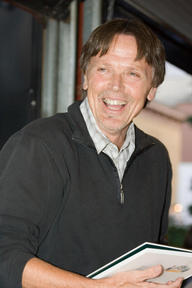 |
Cultural and culinary delights
with AUTO
by Hinke Osinga,
University of Bristol, UK |
|
Eusebius
Doedel, July 2007; photograph by Kurt Lust.
|
|
Eusebius Doedel, or Sebius for short, has worked at
Concordia
University for almost 30 years. Nevertheless, he enjoys a life of
many travels and visits several countries around the world on an
annual basis. What is his secret? Or is this lifestyle a thing of the
past and will the next generation never be able to enjoy such academic
freedom?
The making of AUTO
Sebius's career start was perhaps a bit unusual. Born
in The Netherlands, he received a mechanical engineering-oriented
variant of high-school education that got him a diploma at the age of
19. Sebius recalls that engineers from Boeing came to The Netherlands
to recruit people for their company in Seattle. In fact, he was
offered a job with Boeing as an Associate Tool Engineer!
Unfortunately, the economic situation changed in the US and he did not
get the required `labor certificate' that would allow him to emigrate
to the US. At the same time, the threat of mandatory military service in
The Netherlands made him eager to leave the country. Therefore, he
decided to go to Canada instead, because members of his family had
emigrated there earlier, and it was easy to find work with a transport
company. It did not take long, however, before he needed another
challenge and he tried to find a job in mechanical engineering. He
soon found out that he would need to get a university certificate to
reach his goals.
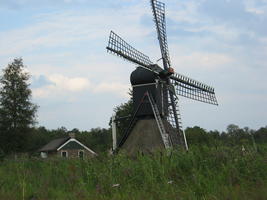 |
|
 |
| Scene at the
`Weerribben' and Sebius operating a cable ferry, near where he was
born in The Netherlands, August 2005. |
"And so I decided to go to university and study
what I liked best: mathematics." Sebius chose the University of British
Columbia (UBC). "With my engineering background I was rather
practical and mostly interested in numerical analysis and the
computational side of mathematics. UBC had very good computers; for
example, they already had an Adage graphics computer in the early
1970's!" The universities were expanding at that time and UBC had
hired several young enthusiastic professors from places like Stanford,
Caltech and Berkeley. After obtaining a BSc, Sebius stayed on to study
for an MSc with Jim Varah. "Jim was only slightly older than I and
very enthusiastic. It was such a great experience that I stayed even
longer to obtain a PhD." In fact, Sebius did not exactly work on the
problem that Jim Varah gave him. He went off on a tangent and
developed a method for solving boundary value problems with high-order
accuracy. "I remember meeting Jim one day and he had great news to
tell: `Sebius, I know what your method is called; it is called
collocation!' (Russell, R.D., and Shampine, L.F., A collocation
method for boundary value problems (I and II), Num. Math.
19: 1-28, 1972.) Alas, Sebius's results were, hence, not as
original as he had thought, but Jim Varah was no less enthusiastic
about the fact that Sebius had, after all, figured it out by
himself. "Jim had been at Caltech and he recommended me to
Herb
Keller. It took a letter from Jim and Herb offered me a
postdoctoral position at Caltech –– well, I still had to
write my PhD thesis, and Caltech only paid me half my salary until I
received my PhD, so I finished it really quickly!"
 |
|
Sebius
speaks very fondly of Herb Keller and it is clear that Herb has been
of great importance for his career. "Sadly, Herb passed away on January
26 this year." [Ed.: see also the announcement
in this issue.] The last time Sebius saw Herb was in July 2007 during
the small workshop at the Centre de Recherches Mathématiques in
Montreal on the occasion of Sebius's 60th birthday. "Herb was
incredibly inspirational. He used to give courses at Caltech: we would
go for lunch first and Herb would come up with an idea for his course;
then he would spend two hours teaching, where he would discuss the
idea, work out some of the details, but leave it as an open-ended
problem. It was in these courses that I learnt about things like a
Hopf bifurcation."
|
| Sebius with Herb Keller, July 2007;
photograph by Kurt Lust. |
|
At the time, Herb Keller was
working on continuation methods and wrote the seminal paper Numerical solution of bifurcation and nonlinear
eigenvalue problems [in Applications of bifurcation theory
(Proc. Advanced Sem., Univ. Wisconsin, Madison, Wis., 1976),
pp. 359-384. Publ. Math. Res. Center, No. 38, Academic Press, New
York, 1977]. Sebius had started working on a software program to solve
nonlinear two-point boundary value problems with the use of
collocation methods and Herb asked him to help with the examples and
produce a nice illustration.
|
|
"I
must have mixed up Herb's example with
the examples I used in my own paper" [Ed.: Finite difference collocation methods for nonlinear
two-point boundary value problems SIAM J. Numer. Anal.
16(2): 173-185, 1979]. "Years later R.R. Huilgol from Australia
contacted Herb and asked about the figures and associated equations; it
turned out that they did not match!" The underlying dynamical systems
in both papers had a particular form using polynomials. "Luckily I was
able to reconstruct the polynomial coefficients based on the figures
in Herb's famous paper!"
|
|
 |
| Awaiting an Indian meal in
Bristol, March 2004. From left to right around the table: David Lloyd,
Róbert Szalai, Bernd Krauskopf, Jan Sieber, Gábor Orosz,
Bart Oldeman, Bob Wieman, Frank Schilder, Hinke Osinga, and Sebius
Doedel. |
 |
|
After a
two-year postdoc with Herb Keller, Sebius went to Vanderbilt
University to work with George Reddien. "George had visited
Caltech before and was very much interested in bifurcation theory. He
really reinforced my interest in dynamical systems and I began
wondering what would be a good way to compute and follow periodic
solutions." Already after 18 months, Sebius left Nashville and took up
an Assistant Professorship in the Faculty of
Engineering and Computer Science at Concordia University in
Montreal. "I started at Concordia in the winter of 1979 and
essentially developed AUTO in less than a year." Most young Assistant
Professors find it difficult to adjust to their new job and in their
first year they are more occupied with preparations for teaching than
doing research. "Things at Concordia were excellent! My office was
located in the attic of an annexe building; one had to negotiate a lot
of stairs and get past the secretary who operated like a watch
dog. Only the best students were able to find me!"
|
Sebius and Bob Russell (Simon
Fraser University) at a social event during the conference in honor of
Bob's 60th birthday, August 2005.
|
|
The truth is that
Sebius only taught one course that semester, on the topic of Numerical
Methods, and he very much enjoyed preparing for it. However, he also
realized that his research should not suffer and he set himself firm
deadlines. "In the summer of 1980 I visited UBC and gave my first
presentation on AUTO. I then refined my results and completed the work
at Concordia in the fall."
|
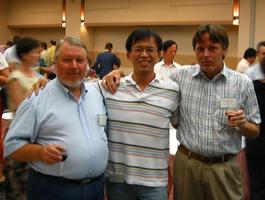 |
|
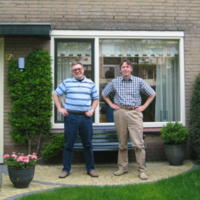 |
| André Vanderbauwhede
(Ghent University), Kuo-Chang Chen (National Tsing Hua University,
Taiwan) and Sebius at a conference in Kyoto, July 2006. |
Yuri Kuznetsov (Utrecht University)
and Sebius Doedel at Yuri's home, The Netherlands, April
2004. |
Reaping the rewards of AUTO
Almost immediately after his first seminar, several
people saw the potential of Sebius's results. In particular,
Jean-Pierre Kernévez from the Université de Technologie de Compiègne
(UTC) was extremely interested. "I met Jean-Pierre Kernévez at
a conference in Banff in August 1980. He invited me to come to France
and I went to Compiègne for the first time shortly after this
meeting." This visit triggered a regular series of research
visits to UTC. Concordia University has long summers; from April to
September one does not have any teaching obligations. "Of course, you
could teach summer schools, but I would never teach in the summer. I
spent my summer breaks in Compiègne with Jean-Pierre
Kernévez. He was an incredibly nice man and would invite me
with my entire family to stay in his house. These visits were a great
experience. The atmosphere at his house was fantastic and we all
enjoyed it enormously. We would have great food and talk a lot, always
in French. Overall, it was a magnificent cultural experience."
Obviously, the research visits were not exactly luxurious
holidays. "Oh no, Jean-Pierre and I worked incredibly hard! We would
start work at nine in the morning and finish only at midnight. Of
course, this did include a seriously long dinner, but really, the
entire time would be focused on work."
 |
|
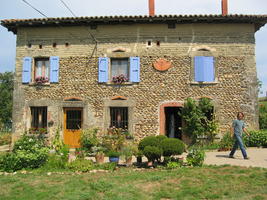 |
| The view from Sebius's
customary hotel room in Puebla, Mexico. |
Alain Léger (CNRS, France)
at his home in Hauterives, France, August 2004. |
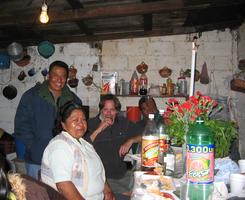 |
|
The
experience of being totally immersed in a foreign culture is clearly
what Sebius values enormously. He has traveled to many countries, not
just once, but regularly for research visits that grew into long-term
collaborations and often have been extremely fruitful and
successful. Most of Sebius's sabbatical leaves, the first one in 1985,
were spent at Caltech with Herb Keller. "Herb Keller was a
fantastic host. He would give moral and technical support, while I
could work on whatever I fancied." The visits to Caltech were usually
extended and lasted sometimes more than a year. "Once I was at Caltech
for almost three years!" Sebius admits cheekily.
|
Invited for dinner with friends
in Puebla, Mexico, January 2008.
|
|
Financial support for
such endeavors would be a combination of stipends for his sabbatical
leave and support from Herb Keller during the extended period of
unpaid leave. Often the net income would actually be less than what
Sebius would earn at Concordia, but adventures and experiences clearly
outweighed this minor inconvenience. "My visits to Caltech could be
compared to the kind of Research Fellowships that exist nowadays in
some countries for Assistant/Associate Professors. They were fantastic
opportunities to focus completely on research."
|
 |
|
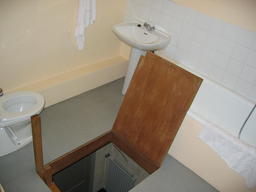 |
| Sebius's favorite
room in the Erasmus hotel in Ghent, Belgium, can be accessed only via
stairs that lead to its bathroom. |
|
Other
long-term research collaborations followed. In 1994, Sebius began
visiting Alejandro Rodríguez Luis (and later also Jorge
Galán Vioque) at the Universidad de Sevilla. They met at a small
workshop on numerical methods for bifurcation theory and dynamical
systems, organized annually by Yuri Kuznetsov at the CWI in
Amsterdam. In 1997, Sebius met Carlos Pando Lambruschini from the Benemérita
Universidad Autónoma de Puebla, who attended a course
Sebius gave at the Centre de Recherches Mathématiques in
Montreal.
|
|
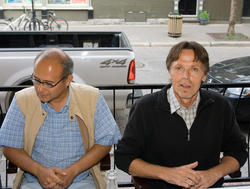 |
Sebius with Carlos Pando, July 2007; photograph by Kurt Lust.
|
|
Both Spanish and Mexican
researchers had interesting and challenging research projects that
could be tackled using AUTO. For Sebius, the added benefit of these
collaborations would be the cultural experience and the foreign
language. "You do not go there as a tourist. You live there, you go to
work like everybody else, and then you get invited to weddings,
parties, religious celebrations, etc. Particularly in Mexico I found
it very easy to make friends with the local people. In Puebla we start
late and from 8:30 to 10:30am I can be found on the Zócalo to
practice my Spanish and chat with the local people. I regularly meet
up with entire families! Then I go to the university and Carlos and I
work 11-6 with only a short break for a light
lunch."
|
 |
|
 |
| On a hike with
friends near San Bernardino Tlaxcalancingo, Mexico, February
2008. |
A lifestyle of the
past?
Sebius
clearly is a master of combining business with pleasure, but one
wonders whether he was also extremely lucky in that he just happened
to be making his career in a time where it was easy to maintain his
lifestyle. Certainly, he was extremely lucky that his wife had a job
that she could easily (and was willing to) leave. "The kids have been
to schools in Alhambra (CA), Salt Lake City (UT), Minneapolis (MN),
Cuernavaca Mexico... It probably was rather disruptive, but it was
also very good for them." One also gets the
impression that the teaching load has gone up, but Sebius has, in
fact, been teaching two courses per semester almost every year that
he was not on leave.
|
|
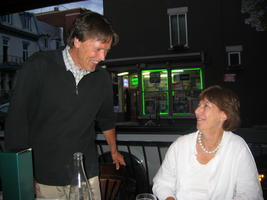 |
| Sebius and his wife
Adrienne enjoy the speeches in honor of his 60th birthday,
Montreal, July 2007. |
|
"I do feel that teaching seemed
to take less time
in those days. I now spend a lot more time to prepare my classes
–– and not necessarily with a better result!
–– because new technologies allow you to make better
lecture notes; students also expect more from you in this
sense. Moreover, student evaluations did not matter as much as they do
now." Sebius definitely thinks that the increased bureaucracy at
universities has made it much more difficult to organise frequent and
long-term research visits. "There is so much more pressure now at
higher level to measure the research quality. Of course, I would have
to undergo regular internal reviews to assess my research and
teaching, but these were always very good. Just the software
developments for AUTO or a single high-quality paper would be
considered a good achievement. Things have changed in that respect:
the measure is much more focused on quantity, impact factors, and
citations. These are dangerous tools in the hands of bureaucrats,
because they have no idea what it means to do research."
 |
|
 |
|
The
author of this article with husband (Bernd Krauskopf, University of
Bristol), leaving Sebius's home in Montreal on their way to the
airport, March 2008. |
|